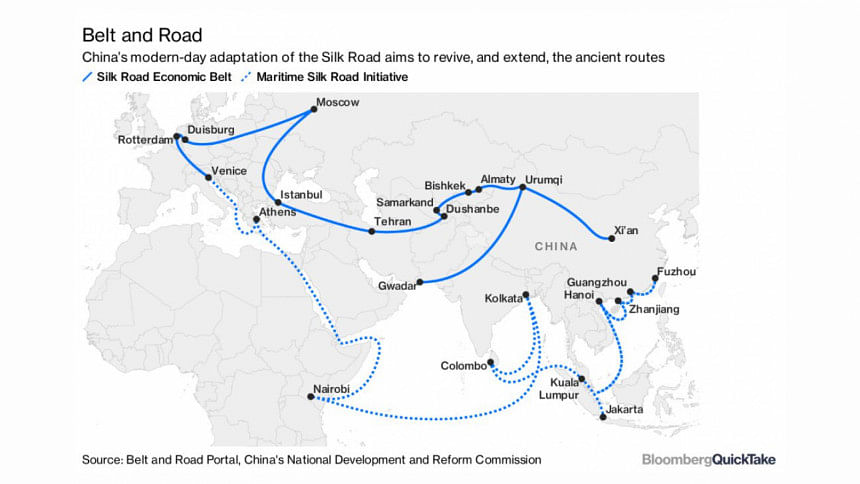One Belt, One Road: We must secure our interest

The ancient Silk Road, of which the Belt and Road Initiative is a gigantic new avatar, dates back to the Chinese Han Dynasty's westward expansion more than 2100 years ago. The Road derived its name from the lucrative silk trade along the routes through which it branched into what are today the central Asian countries Kyrgyzstan, Tajikistan, Kazakhstan, Uzbekistan, Turkmenistan, Afghanistan, as well as present-day Pakistan and India to the south. These routes eventually spanned 4,000 miles to Europe.
Interestingly, silk was regarded as more precious than gold as a commodity in those times as if to convey the misty romanticism with the old world charm about a fine fabric. At any rate, the Silk Road by no means offered silken smooth passage to travellers like Marco Polo, let alone caravans, as they had to negotiate the steppes, the nickname for Silk Road that tired travellers muttered in the company of their guides!
Bloomberg, in an article, has outlined the New Silk Road, the Proposed Silk Road Routes, the Silk Road Economic Belt and the 21st Century Maritime Road on a composite map. The routes girdle Rotterdam, Venice and Moscow to the north- west; North Korea, Mongolia Kunming, Kolkata, Dhaka and Chattogram (shaded) to the east; and Nairobi and Jakarta to the south. The Chinese and the Portuguese had known of the Chittagong port since very olden times for its fame. It was named "a great port" or "Porte Grande" in Portuguese as gleaned from Dr Ainun Nishat.
On December 15, 2016 the media in Dhaka and Beijing were abuzz with superlatives—"Dhaka , Beijing upgrade ties; sign biggest ever investment deals; agree on Silk Road Initiative"—on the occasion of Chinese President Xi Jinping's visit to Dhaka.
Unfortunately, most of the ten major projects inked with Chinese assistance—Padma Bridge (Rail Link); Marine Drive Expressway; Expansion, Strengthening of Power System Network' Power Plant in Payra, Karnaphuli Tunnel—to name the obvious ones, remain metaphors for sluggish implementation.
It was during the Chinese president's historic visit to Dhaka that the Road and Belt vision was unravelled in clearer terms, including where Bangladesh fits into the envisioned infrastructural paradigm shift. A China Daily report explained how China refocused on South Asia realising that "northern part of South Asia is key for the Silk Road Economic Belt while the southern part is important for the 21st Century Maritime Silk Road."
A report in the People's Daily on October 13, 2016 pointed out that "Bangladesh as an important South Asian country located off the Bay of Bengal, can be China's key partner in building the Silk Road Economic Belt and the 21st century Maritime Silk Road."
The planned building of an economic corridor linking Bangladesh, China, India and Myanmar despite initial commitments of the countries concerned appears to be witnessing a certain foot-dragging on the part of Myanmar. The prospects for road and rail linkages in sub-regional terms which seemed realisable vis-a-vis Nepal and Bhutan are having to meet with Myanmar's unabashed diffidence. Now BCIM corridor has taken a back seat to Bimstec and BBIN; the last-named include Bangladesh, Bhutan, India and Nepal.
China in a latest overture has put forward an excellent open-ended proposal. This concerns running superfast Bullet Train on Kunming-Kolkata-Dhaka-Chattogram routes and back.
Since the announcement of the Belt Road Initiative by China in 2013, the proposed embellishments to trade, investment and travelling links have been embraced, even owned up, by 34 countries and 70 organisations.
To scale down the "overwhelming" nature of the multi-dimensional undertaking, China has lately soft-pedalled the idea, if you will, saying it is not a "Chinese project" as such. On the contrary, it is a global undertaking with past roots and traces. Thus, friends and foes alike are welcome to join in. Clearly, the key to success of the intercontinental arterial networking lies in a consensual approach to and coordinated participation by the countries en route.
Although exponential growth in trade, investment, industry and technology is the most likely outcome for the countries embracing One Belt, One Road super-connectivity, China obviously stands to gain the most. For one thing, she is the largest exporter in the world, so will be a beneficiary of multiple trade options promised by the gargantuan venture. For the other, the heightened trade war between the US and China provides a justification for the project. It can be an answer to the rabid form that protectionism has taken on manifestly as an expression of economic xenophobia.
Of course, China's sphere of geopolitical influence will grow with the expansion of economic links, and the Chinese currency Renminbi may get a bit closer to replacing the US Dollar, an agenda China perhaps keeps close to its heart.
One only hopes that integrated infrastructure accompanied by primacy of economic development across the board will create conditions conducive to harmony and coexistence between communities. With that happening what now may appear as a maelstrom of religious extremism and terrorism will dissolve into the ether.
Shah Husain Imam is Adjunct Faculty at East West university, a commentator on current affairs, and former Associate Editor, The Daily Star.
Email:[email protected]










Comments